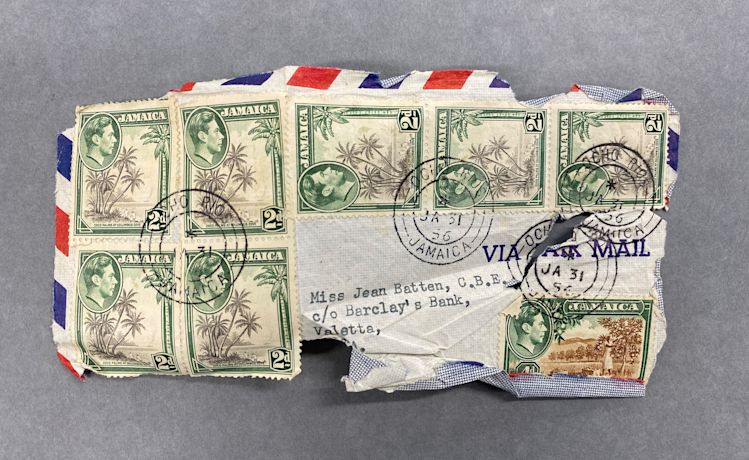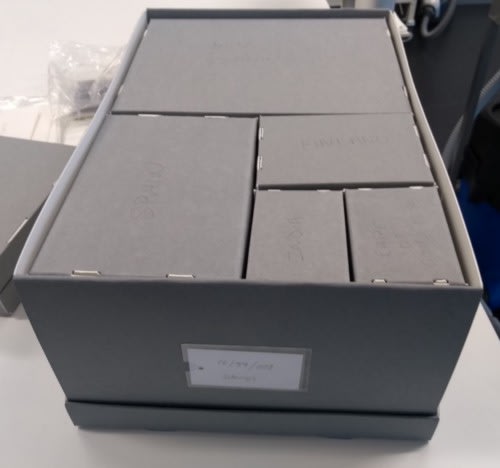Jean Batten's Stamp Collection

In 1990 the National Library of New Zealand’s Sub-Committee on strengthening Resources supported MOTAT’s Walsh Memorial Library in purchasing a lot of Jean Batten memorabilia from the Hendon Aircraft Sale at Sotheby’s. This included aero club badges, stamps, first day covers and other ephemera addressed to Batten.
![Unknown photographer. [29 Apr 1935]. [Jean Batten waving to supporters during after arrival in Croydon], PHO-0192–1.24. Walsh Memorial Library, The Museum of Transport and Technology (MOTAT). No known copyright restrictions.](https://images.ctfassets.net/mplktqcfflsk/39cbq4Qfbyw3huCMrhWoRm/1a8c646c69dc9149138a0c4b1114763b/PHO-0192-1.24_001_ACC.jpg?w=1002&h=800&fl=progressive&q=85&fm=jpg&bg=transparent)
Since March, between the two Covid rāhui, Library and Conservation have been working together to take care of this stamp collection, which numbers over 1000 stamps. Previously housed loose in overfilled envelopes, we have begun the process to put them into stamp stock sheets, making them easily accessible for researchers to view. As part of this process, we will also look to attach a finding aid and create further records for Collections Online.
Based on the work we’ve done so far; it appears the stamps were collected as a result of correspondence sent to Jean Batten and the stamps offer a cursory glance into where she received mail from throughout her life, spanning from the 1930s to the 1980s and 62 countries.
![Example of half letter from Iraq. [Series of philatelic material], 16/059/001. Walsh Memorial Library, The Museum of Transport and Technology (MOTAT).](https://images.ctfassets.net/mplktqcfflsk/7APt9FmnOi6Au8dijdGf7p/b81aa0efbc619951c09f50ad3bc512cc/Image2.jpg?w=600&h=800&fl=progressive&q=85&fm=jpg&bg=transparent)
Most of the stamps are used, torn from envelopes. We’ve also noticed a few envelope edges with her name on. And even a half letter, shown on the left.
So far, the stamps have been sorted by country of issue and we are now going back through each country, counting the number of stamps and measuring them to help determine the storage requirements for the collection, as well as recording how many stamps require flattening, or other conservation treatments. Recording how many stamps require each kind of treatment will help us to plan our treatment strategy so that we can work as efficiently as
possible. Researchers tend to look out for country and date of issue, so these are our how we will arrange the collection.
Conservation Considerations
One of the key early decisions made during the project was not to remove stamps from their envelope backings unless that backing poses a risk to the stamp. Many of the envelope fragments contain contextual information that may be of value to researchers such as: postmarks, cancellations, addresses, air mail markings, and fragments of letters or other
writing.
![Example of a letter addressed to Batten from Jamaica. [Series of philatelic material], 16/059/001. Walsh Memorial Library, The Museum of Transport and Technology (MOTAT).](https://images.ctfassets.net/mplktqcfflsk/4nTGrkonVLOLgJJY5YBAIg/bfecfd2b9f1f4dbaef237a3aca1e3e8c/Image3.jpg?w=1303&h=800&fl=progressive&q=85&fm=jpg&bg=transparent)
The fact that so many of the stamps are still adhered to envelopes also suggests much about the manner in which they were collected. In cases where the backing conveys no additional information but is not deemed harmful to the stamp, it will be trimmed down for storage, leaving a wide enough border around the stamp to protect the perforations.
Leaving the stamps on their backings also removes the need to expose otherwise stable stamps to the high levels of moisture required to make the gum adhesive soluble. Any stamps requiring treatments commonly achieved via humidification, such as flattening, will require systematic solubility testing before treatment is undertaken. This involves testing every part of the stamp and envelope including: all the colours of ink used to print the stamp, the ink of any cancellations or postmarks, the envelope itself if it is coloured or printed in any way, and the ink of any writing on the envelope.
As one envelope fragment may have many different stamps on it, as well as coloured paper, cancellations, postmarks and writing, the testing itself may be a major undertaking. One of the reasons that it is important to test the solubility of the stamp ink is due to the fact that, in the past, some stamps were printed with extremely water-soluble aniline inks. This was done intentionally by postal services in many countries to prevent a stamp being soaked off an envelope and reused for postage. When exposed to moisture, these inks bleed out into the surrounding paper, causing the image to blur or, in extreme cases, wash off the paper entirely.
![Example of a stamp at sorting process. [Series of philatelic material], 16/059/001. Walsh Memorial Library, The Museum of Transport and Technology (MOTAT).](https://images.ctfassets.net/mplktqcfflsk/3cRIW55icWadf5ytolv2ey/64a8ed8a80783219166aee91d8c9f66c/Image4.jpg?w=1067&h=800&fl=progressive&q=85&fm=jpg&bg=transparent)
The sorting process has also given us a chance to trial using the Gunnar Computerised Mat Cutter to create a modular box system to fit within one of our standard-sized boxes. When first sorting the stamps it quickly became apparent that we needed a way to store them between sorting sessions that prevented them becoming mixed up again.
We initially assigned each country a small, commercially produced box, however we soon realised that a more bespoke solution was needed as the volume of stamps from countries such as New Zealand and Great Britain quickly exceeded the capacity of these boxes. The commercial boxes also didn’t fit neatly into the larger standard-sized box, leaving gaps that allowed them to shift around inside when the larger box was moved. With no other suitable boxes in stock, we decided to develop a modular box system based on the internal dimensions of the standard-sized storage box already used to house the collection.

This would allow us to produce boxes in a range of sizes, all of which would fit neatly together within the larger box. Once the dimensions of each box size were determined they were programmed into the Gunnar software and saved as a “nest”. The nesting feature of the Gunnar allows multiple boxes or mats to be cut at once with the software automatically determining the most efficient layout to maximise board yield.
Nesting is a great way to use up offcuts from other projects as the software will try to cut as many boxes as possible out of whatever sized board you have. In this case it allowed us to cut all 45 stamp boxes from offcuts. Nests can also be saved so that, should we ever need more boxes of these sizes, they are already in the software ready to go. We are currently exploring how we can use this kind of modular system and the Gunnar to rehouse other small objects.
It seems Jean Batten was consciously collecting these stamps, but little appears to have been done to them before they made their way to MOTAT. We welcome any enquiries about this collection and look forward to making it accessible to researchers in the future once rehoused.
By Kasserine Ross Sheppard (Conservation) and Chelsea Renshaw (Library and Archives), MOTAT.
Please feel free to email MOTAT.Library@motat.org.nz or Kasserine.RossSheppard@motat.org.nz with any enquiries about this collection.